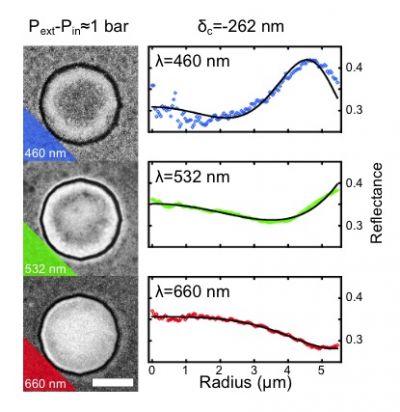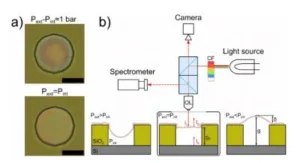The University of Delft and Graphenea SA (a Spain-based graphene company) have published some research that outlines a new way of making an IMOD (interferometric modulator display) similar to the not so successful Mirasol display. While the Mirasol was pretty far developed in terms of performance this new development is really at the beginning at the moment and describes a physical effect that could be used to create a reflective display based on interferometric modulation to create color. The paper is called “Colorimetry technique for scalable characterization of suspended graphene“.
The research describes the effect of using graphene films covering depressions in silicone and how the graphene film stretched over these depressions changes the reflected color based on the way and amount the graphene film is stretched. The researchers stretched the film via air pressure, a way that will certainly not work in a pixelated display.
The physical basis for the color shift of the reflected light is what we all know as Newton rings.
As they describe it, bending the films outwards or inwards will shift the reflected light and create a colorization of the reflected light. As with all IMOD devices the color response is by no means a narrow band color like we are used to in RGB LED and laser devices. The following image shows this very clearly.

Nevertheless, the concept creates a RGB pixel structure that would allow the design of a very low power reflective color display. As with Mirasol, the color would not be very saturated and will depend on the incoming light.
This research was more or less coincidental as the researches were trying to characterize the graphene films in order to use them for sensory purposes. They noticed that at certain pressures the reflected light changed color giving them the idea that this is a way to develop a low power color display. They are far away from developing a display that may be useful for consumer or professional devices. For now, this is just another way of making an IMOD panel that so far was not able to successfully makes its way into any electronic devices. (NH)

